Related Research Articles

The Norton Motorcycle Company is a brand of motorcycles, originally based in Birmingham, England. For some years around 1990, the rights to use the name on motorcycles was owned by North American financiers.
Triumph Engineering Co Ltd was a British motorcycle manufacturing company, based originally in Coventry and then in Meriden. A new company, Triumph Motorcycles Ltd, based in Hinckley, gained the name rights after the end of the company in the 1980s and is now one of the world's major motorcycle manufacturers.

The Triumph Trident and BSA Rocket 3 was a technically advanced, high-performance roadster motorcycle made by Triumph Engineering and BSA from 1968 to 1975, and sold under both the Triumph and BSA marques. Alongside the Honda CB750, and later the Kawasaki triples, it brought a new level of sophistication to street motorcycles, marking the beginning of the superbike era. The Honda CB750 overshadowed the Trident to be remembered as the 'first superbike', in spite of the Triumph Trident actually debuting before the Honda by a few weeks.

The Triumph Bonneville is a standard motorcycle featuring a parallel-twin four-stroke engine and manufactured in three generations over three separate production runs.

Geoff Monty was an English professional motorcycle racer, constructor, rider-sponsor and retail dealer, initially based in Kingston on Thames and later – under the name Monty and Ward – Twickenham areas, near London, with a move to Edenbridge, Kent by 1968.

The BSA Gold Star is a motorcycle made by BSA from 1938 to 1963. They were 350 cc and 500 cc single-cylinder four-stroke production motorcycles known for being among the fastest bikes of the 1950s. Being hand built and with many optional performance modifications available, each motorcycle came from the factory with documented dynamometer test results, allowing the new owner to see the horsepower (bhp) produced.
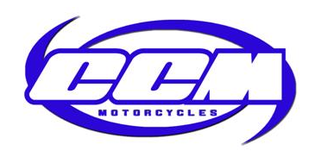
Clews Competition Machines (CCM) is a British motorcycle manufacturer based in Bolton, England. CCM was founded in 1971 by Alan Clews and, gained notability for producing specialised BSA powered motocross machines. The company has produced a variety of motorcycle models over its history using a variety engine suppliers including; Rotax, Suzuki and Kymco.
Norton-Villiers was a British motorcycle manufacturer formed in the 1960s following the collapse of AMC. With the general decline of the British motorcycle industry, under a British Government initiative it was later combined with the remnants of BSA Triumph to form Norton-Villiers-Triumph.

The Norton Commando is a British Norton-Villiers motorcycle with an OHV pre-unit parallel-twin engine, produced by the Norton Motorcycle company from 1967 until 1977. Initially having a nominal 750 cc displacement, actually 745 cc (45.5 cu in), in 1973 it became an 850 cc, actually 828 cc (50.5 cu in). It had a hemi-type head, similar to all OHV Norton engines since the early 1920s.

Armstrong-CCM Motorcycles was a British motorcycle manufacturer based in Bolton, England. Alan Clews formed CCM in 1971 from what was left of BSA's off-road competition team and bought spares to produce his own motorcycles. This was a successful business and the Bolton factory was established. In 1981 Armstrong bought a majority share and Clews designed a road race competition motorcycle. They acquired the rights to the Rotax engine enduro motorcycle SWM XN Tornado from the Italian owners and developed the Armstrong MT500 military motorcycle used by the British Army.
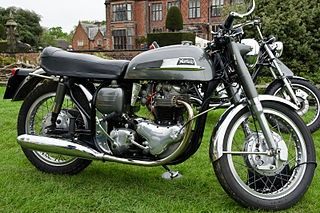
The Dominator is a twin cylinder motorcycle developed by Norton to compete against the Triumph Speed Twin. The original Dominator was designed in 1947 and 1948 by Bert Hopwood, who had been on the Speed Twin design team at Triumph. Available for sale from mid 1949, this design set the pattern for Norton twins for the next 30 years.
The Thruxton 500 was a motorcycle endurance race for production based road machines, covering 500 miles and ridden by a team of two riders per machine. The first event was a 9-hour race which took place in 1955, organized by the Southampton and District Motorcycle Club (SDMCC) at the Thruxton Circuit near Andover in Hampshire. Two more 9-hour races followed in 1956 and 1957.
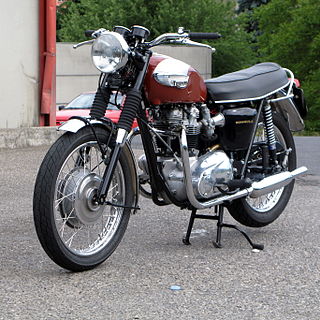
The Triumph Bonneville T120 is a motorcycle originally made by Triumph Engineering from 1959 to 1975. It was the first model of the Bonneville series, which was continued by Triumph Motorcycles Ltd. The T120 was discontinued in favour of the larger 750 cc T140 in the early 1970s.

The Triumph Bonneville T140 is a standard motorcycle with a 750 cc (46 cu in) capacity engine that was designed and built by Triumph Engineering at Meriden near Coventry.

The isolastic frame, designated by Norton as GlideRide, used a system of engine-to-frame mountings incorporating rubber bushes to isolate the vibration of the vertical twin engine from the frame and rider. The isolastic frame was developed for use with the Commando inclined engine, whilst the Featherbed frame continued in production for the Mercury with a softer-specification 650 cc vertical-engine until 1970.

Mead & Tomkinson was a motorcycle and car dealership in Hereford Gloucester, and Tewkesbury. Three of the Tomkinsons, sons Chris and Patrick, and their father, Mike, successfully built and fielded racing motorcycles. They concentrated on the Isle of Man TT and on 24-hour and 8-hour endurance races at Spa, Barcelona, Thruxton and the Le Mans Bol d'Or. One of their riders was Neil Tuxworth.

BSA motorcycles are made by the Birmingham Small Arms Company Limited (BSA), which was a major British industrial combine, a group of businesses manufacturing military and sporting firearms; bicycles; motorcycles; cars; buses and bodies; steel; iron castings; hand, power, and machine tools; coal cleaning and handling plants; sintered metals; and hard chrome process.
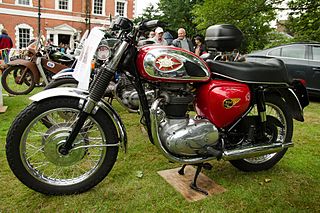
The BSA unit twins were a range of unit construction twin-cylinder motorcycles made by the Birmingham Small Arms Company (BSA) and aimed at the US market. A range of 500 cc (31 cu in), 650 cc (40 cu in) and 750 cc (46 cu in) twins were produced between 1962 and 1972, but they were really developments of the older pre-unit A7/A10 model range with less weight. The engines had a reputation for vibration, but acceleration was good for the time, to a top speed of 100 miles per hour (160 km/h).
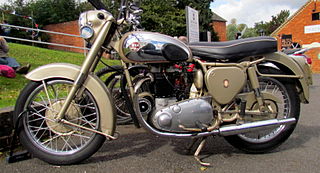
The BSA A10 series was a range of 646 cc (39.4 cu in) air-cooled parallel twin motorcycles designed by Bert Hopwood and produced by Birmingham Small Arms Company at Small Heath, Birmingham from 1950 to 1963. The series was succeeded by the A65 unit construction models.

The BSA B25 was a series of 250 cc (15 cu in) unit construction single-cylinder OHV four-stroke motorcycles made by the Birmingham Small Arms Company. Developed from the BSA C15, the machines were produced between 1967 and 1971. The B25 was the fastest British production 250.
References
- 1 2 "B50 history". Archived from the original on 27 October 2010. Retrieved 9 October 2010.
- ↑ Ryan, Ray; Forsyth, Bill; Holland, Jeremy (28 August 2003). Motocross Racers: 30 Years of Legendary Dirt Bikes. Motorbooks International. ISBN 0-7603-1239-7.
- ↑ "BSA B50 Racing History". b50.org. Retrieved 20 March 2012.
- ↑ "BSA". classicmotorcycles.org.uk. Retrieved 20 March 2012.
- ↑ Westworth, Frank (1998). The British Classic Bike Guide. Haynes Publishing. ISBN 1-85960-426-9.
- ↑ "Trophy Trail / Adventurer (TR5T)". Triumph Owners' Motor Cycle Club. 15 March 2018. Retrieved 25 February 2020.
- ↑ Salvadori, Clement (January–February 2010). "1973 Triumph TR5T Trophy Trail 500 - Classic British Motorcycles". Motorcycle Classics. Retrieved 25 February 2020.
- ↑ Tanshanomi, Peter (6 January 2015). "Two Wheel Tuesday: Last Gasp Norton Isolastics". Hooniverse. Archived from the original on 15 September 2018. Retrieved 14 September 2018.
- 1 2 Nebrér, Rickard (18 January 2004). "B100 V Twin" . Retrieved 9 October 2010.